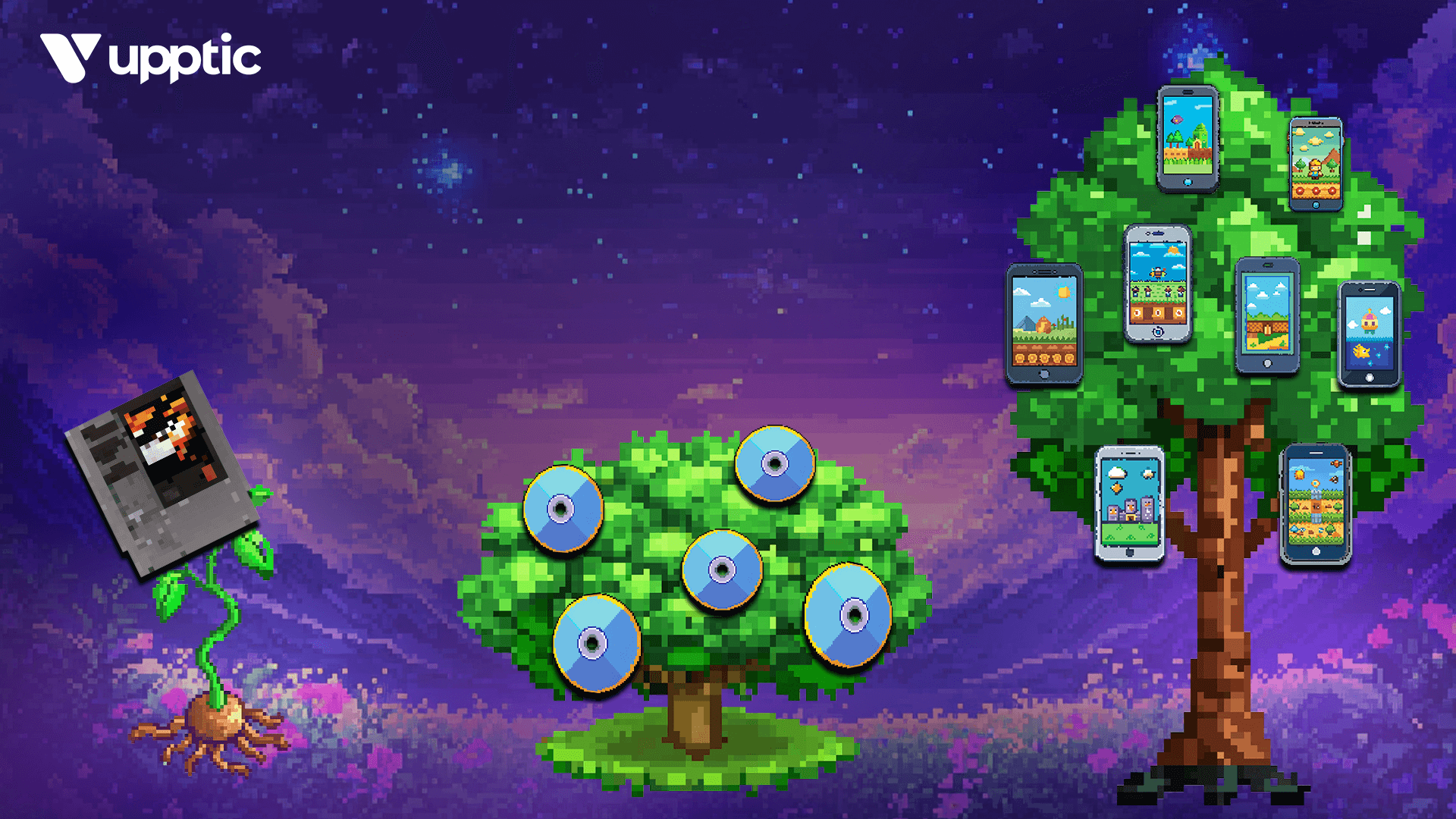In the highly competitive gaming industry, mastering user acquisition (UA) is essential for driving growth and ensuring long-term success. Whether you’re a seasoned game marketer or just starting, understanding and optimizing your UA strategy can make all the difference. At its core, user acquisition is about more than just attracting a large number of users; it’s about finding and engaging high-quality players who will contribute to your game’s revenue and community.
In this guide, we’ll explore the key components of gaming user acquisition – from leveraging the right mix of channels to refining creatives and using data-driven insights – we will provide insights and strategies to help you optimize your approach and achieve sustainable growth in a competitive market.
Chapters
- What is user acquisition for game marketing?
- User acquisition funnel for game marketing
- User acquisition strategies to scale your games
- User acquisition creatives for gaming
- User acquisition tools for game marketers
- User acquisition optimization for your games
- Key Takeaways
What is user acquisition for game marketing?
User acquisition (UA) is a cornerstone of any game’s marketing strategy, pivotal for attracting and retaining players who contribute to the game’s success. In essence, UA involves a variety of tactics designed to get a game seen by prospective players and convince them to download and engage with it. This process can be achieved through organic means or paid advertising, each offering distinct advantages depending on the game’s stage and category.
At the heart of user acquisition is the goal of not just bringing in a large number of users, but securing high-quality players who will have a long-term impact on the game’s revenue. These valuable players are those who engage with your game and make repeated in-app purchases or ad clicks – and ultimately are a part of your gaming community. Successful UA strategies leverage app store optimization, social media marketing, influencer partnerships, and mobile ad networks to maximize the game’s visibility and appeal to the right audience.
One of the critical aspects of effective user acquisition is making informed, data-driven optimizations. By analyzing user behavior and monetization trends, developers and marketers can identify which acquisition channels and strategies yield the highest lifetime value (LTV) users. This allows for more targeted campaigns that enhance return on investment (ROI) and overall game performance. In practice, this means constantly refining marketing efforts based on real-time data to attract users who not only download the game but also stick around and generate ongoing revenue through ad views and in-app purchases.
User acquisition funnel for game marketing
The user acquisition (UA) funnel for game marketing is a multi-stage process designed to turn potential players into loyal, engaged users. This journey is meticulously structured to optimize user engagement and drive revenue at each stage, from initial ad impressions to long-term retention.
Learn about key marketing terms, KPIs, and formulas.
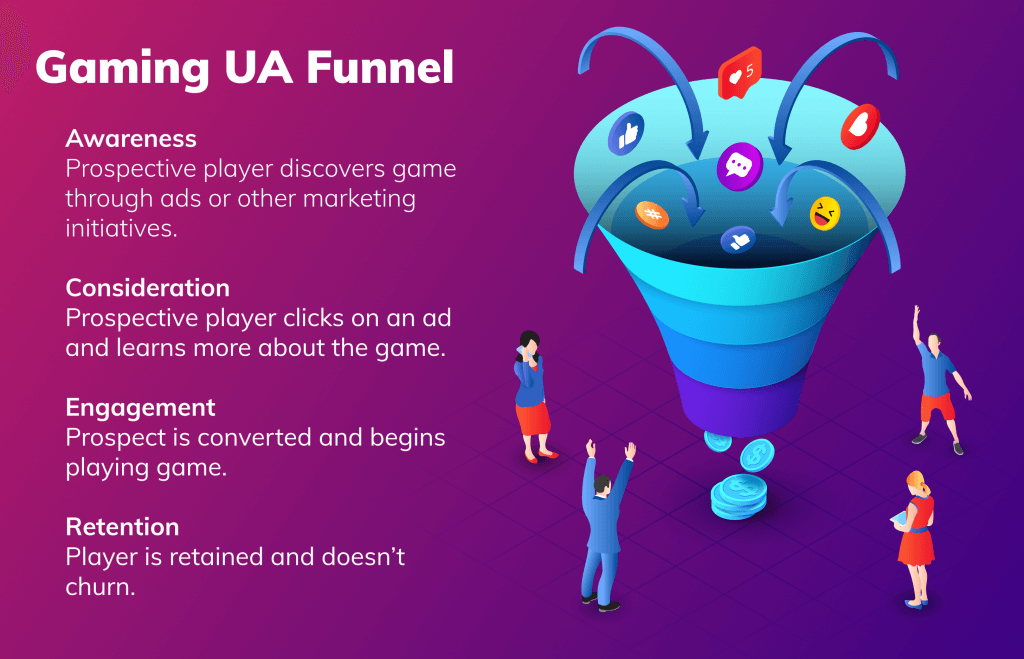
From Awareness to Install: The initial stages
The UA funnel begins with awareness, where potential players first encounter your game through ads on various platforms like social media, search engines, or even influencer partnerships. Effective ads — whether video, playables, or banners — aim to capture attention and generate interest, measured by impressions and click-through rates (CTR).
Once a user clicks on the ad, they enter the consideration stage, exploring more about the game, often through a mix of app store listings, reviews, and additional content. The success of this stage is typically measured by the conversion rate (CVR), indicating how many users proceed to install the game after clicking the ad.
From Install to Engagement: Driving retention
Post-install, the focus shifts to engagement and retention. These stages are critical as they determine the long-term value of the user. Key metrics here include retention rates, daily active users (DAU), and session length. For example, tracking Day 1, Day 7, and Day 30 retention provides insights into how well your game retains users over time. High retention rates suggest a strong onboarding process and engaging gameplay, while low rates may indicate areas where the user experience needs improvement.
Mid-Funnel Optimization: Reducing churn
As users interact with the game, it’s crucial to understand where and why they might drop off, commonly referred to as churn. Metrics like stickiness rate and churn rate help identify these drop-off points. Strategies such as improving the onboarding experience or offering incentives can help reduce churn and keep players engaged.
Bottom-Funnel Metrics: Maximizing revenue
Finally, the bottom of the funnel focuses on monetization and maximizing the lifetime value (LTV) of the user. This stage tracks how well users convert into paying customers through in-app purchases, subscriptions, or ad interactions. Metrics like average revenue per user (ARPU) and return on ad spend (ROAS) are vital in assessing the profitability of your UA campaigns. A solid understanding of these metrics allows you to adjust your marketing spend to optimize ROI effectively.
By meticulously tracking and optimizing each stage of the UA funnel, game marketers can enhance user acquisition efforts, ensuring that the game not only attracts players but also retains them, ultimately leading to sustainable growth and profitability.
User acquisition strategies to scale your games
Scaling a game successfully requires a strategic approach to user acquisition, where finding the right mix of channels can make all the difference. By leveraging a combination of social platforms, search engines, rewarded video networks, and demand-side platforms (DSPs), game developers can reach their target audience more effectively.
Scale your game effectively by understanding the stages of a game launch.
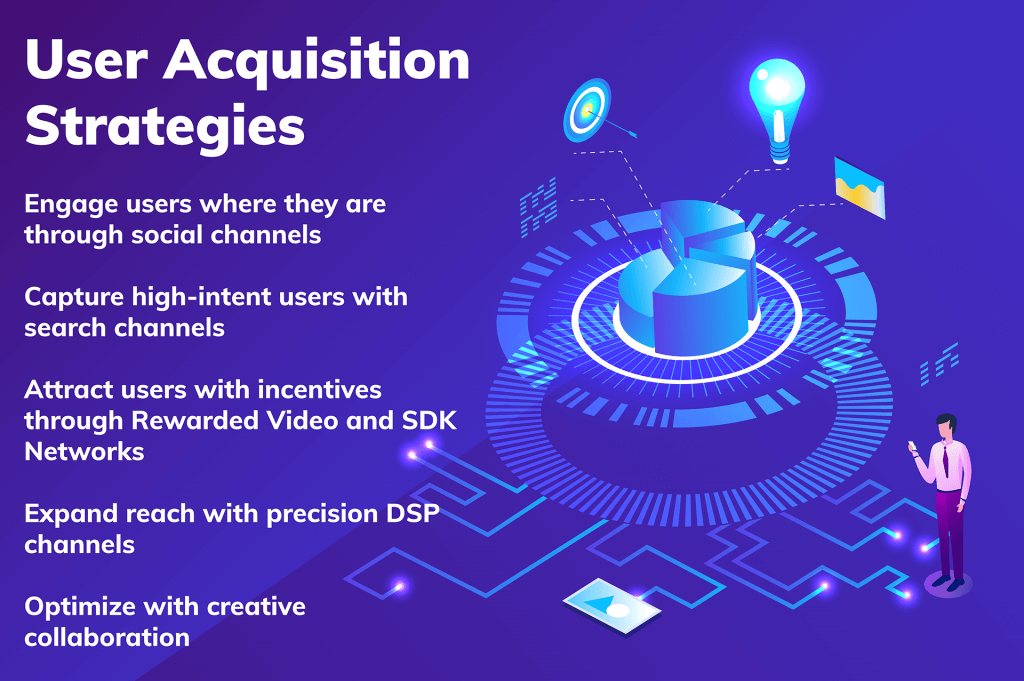
Finding the right channel mix for your audience
To scale your game effectively, it’s crucial to identify the channel mix that resonates best with your target audience, aligns with your creative messaging, and fits within your payback window. The key to success lies in balancing various channels, each offering unique advantages.
Social Channels: Engaging audiences where they spend time
Social platforms like TikTok, Meta (encompassing Facebook and Instagram), Snapchat, and X are powerful tools for reaching diverse gaming audiences. These platforms offer rich targeting capabilities and the potential for viral content, making them ideal for initial user acquisition efforts. Testing creative messaging across these platforms helps in understanding what resonates with your audience, allowing for fine-tuned campaigns.
Learn more about user acquisition strategies for scaling games.
Search Channels: Capturing intent-driven users
Search engines, such as Google and Apple’s App Store, are critical for capturing high-intent users actively searching for new games. Investing in search ads ensures that your game is visible to users who are already interested in similar games, providing a higher likelihood of conversion. Over time, understanding the keywords and ad copy that drive the best results will help optimize these campaigns for better ROI.
Rewarded Video and SDK Networks: Engaging users with incentives
Rewarded video ads and SDK networks, like Unity, ironSource, and AppLovin, offer a unique approach by providing in-game incentives for ad views. These channels are highly effective for engaging users who prefer value exchange experiences. As these ads are integrated directly into the gaming experience, they tend to have higher engagement rates, leading to more effective user acquisition.
Demand-Side Platforms (DSPs): Expanding reach with precision
Once you have a solid understanding of your audience and KPIs, it’s time to explore more niche channels like DSPs. Platforms like Moloco, LiftOff, and Mintegral offer advanced targeting and optimization features, allowing for precise audience segmentation and value-driven acquisition strategies. These platforms are particularly useful as your app matures, providing opportunities to scale while maintaining efficient cost per acquisition.
Optimizing campaigns and collaborating with creative teams
The selection of media sources becomes a crucial part of your strategy. It’s often wise to start with channels that competitors use, such as Facebook, Google, and SDK networks like Unity or AppLovin. As testing progresses, your team can introduce additional media sources, pausing those that underperform and reallocating budget to more successful channels.
As your app matures and your understanding of the payback window and KPIs deepens, you can begin experimenting with niche media sources like incentivized shopping or DSPs. Advanced campaign optimization techniques, such as value optimization, should be introduced to maximize performance. Throughout this phase, close collaboration with your creative team is essential to ensure a steady flow of new creatives that keep your campaigns fresh, engaging, and effective.
User acquisition creatives for gaming
In the competitive world of mobile gaming, attracting and retaining players requires a strategic approach to user acquisition (UA) creatives. From visually striking ASO elements to engaging static ads and compelling videos, each type of creative plays a crucial role in drawing new players and keeping them engaged.
See what your next ad creatives could look like with our creative portfolio!
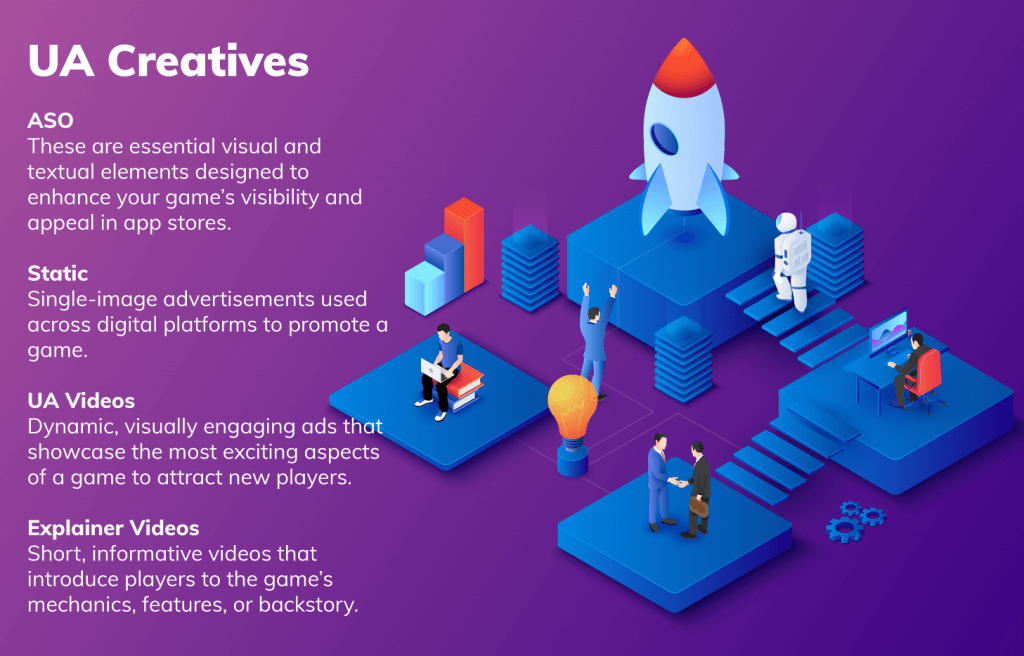
ASO creatives
ASO (App Store Optimization) creatives in gaming are essential visual and textual elements designed to enhance your game’s visibility and appeal in app stores. These include icons, gameplay screenshots, feature highlights, and promotional videos tailored to catch the eye of potential players. The goal is to effectively communicate the game’s core experience and unique features, encouraging users to download. Regular testing and optimization of these elements can lead to improved conversion rates, ensuring your game stands out in a crowded marketplace.
Climb the charts with our ASO services!
Static creatives
Static creatives in gaming are single-image advertisements used across digital platforms to promote a game. These could be banners or social media ads featuring striking visuals and compelling calls to action, designed to grab attention quickly. In gaming UA campaigns, static creatives often highlight key characters, immersive environments, or special in-game events. They are crucial for delivering a clear and immediate message, especially in fast-paced environments where users are likely to scroll quickly.
UA videos
UA (User Acquisition) videos for gaming are dynamic, visually engaging ads that showcase the most exciting aspects of a game to attract new players. These videos typically include snippets of gameplay, epic battles, character introductions, or storyline teasers, designed to capture the viewer’s attention within the first few seconds. Tailored for platforms like social media, YouTube, or in-app ad placements, these videos aim to drive high engagement and conversion rates by making a strong first impression.
To enhance the appeal of UA videos, several creative approaches can be employed:
- Stop-motion videos: Stop-motion techniques add a unique, handcrafted feel to UA videos, making them stand out in a crowded digital landscape. This style can be particularly effective for showcasing character movements or game features in a playful and creative way, offering a fresh perspective that differs from traditional gameplay footage.
- User-generated content (UGC): Incorporating UGC into UA videos leverages content created by actual players, adding authenticity and relatability to the campaign. UGC videos often feature real players sharing their experiences, gameplay tips, or reactions, which can build trust and community around the game. These videos are especially effective on platforms like TikTok and Instagram, where authenticity and engagement are key.
- Gameplay Videos: Pure gameplay videos remain one of the most powerful tools for UA. These videos provide potential players with a direct look at the game’s mechanics, graphics, and overall experience. By highlighting key gameplay moments — whether it’s a thrilling boss fight, an intricate puzzle, or a strategic victory — these videos help players imagine themselves in the game, driving downloads and active participation.
Each of these video types brings something unique to user acquisition efforts, allowing developers to connect with potential players in diverse and impactful ways.
Explainer videos
In gaming, explainer videos are short, informative videos that introduce players to the game’s mechanics, features, or backstory. These videos often combine gameplay footage with narrative voiceovers to guide new players through the game’s world, helping them understand the key objectives and benefits. Explainer videos are crucial during the onboarding process, making it easier for players to grasp the game’s intricacies and feel more confident in their gameplay, which can lead to higher retention and engagement rates.
User acquisition tools for game marketers
In the fast-paced world of mobile gaming, effective user acquisition is crucial for success. Game marketers rely on a variety of tools to optimize their campaigns, track performance, and make data-driven decisions.
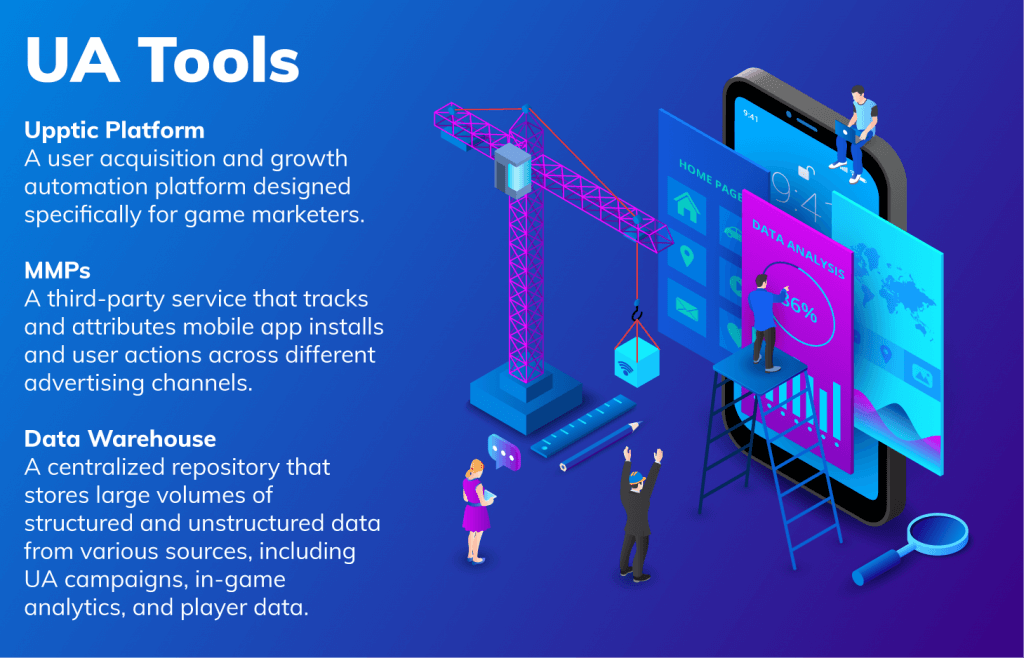
Upptic growth platform
Upptic is a user acquisition and growth automation platform designed specifically for game marketers. It integrates advanced analytics, creative optimization, and machine learning to help marketers drive effective UA campaigns. The platform automates the management of creative assets, runs A/B tests, and optimizes bids across various ad networks, enabling marketers to scale their campaigns efficiently. Upptic also provides tools for player lifecycle management, ensuring that game developers can maximize player engagement and lifetime value.
Take your game to new heights with the Upptic growth platform, now!
MMPs
A Mobile Measurement Partner (MMP) is a third-party service that tracks and attributes mobile app installs and user actions across different advertising channels. MMPs provide game marketers with comprehensive insights into the performance of their UA campaigns, including metrics like cost per install (CPI), return on ad spend (ROAS), and user retention rates. By integrating with various ad networks and platforms, MMPs help marketers understand which channels are driving the most valuable users and optimize their spend accordingly. Popular MMPs include AppsFlyer, Adjust, and Singular for mobile, and Gamesight for PC.
Data warehouses
A data warehouse is a centralized repository that stores large volumes of structured and unstructured data from various sources, including UA campaigns, in-game analytics, and player data. For game marketers, a data warehouse provides the foundation for advanced data analysis and reporting. It allows marketers to consolidate data from different platforms, perform in-depth analyses, and generate insights to guide decision-making. By leveraging data warehouses, game marketers can better understand user behavior, track key performance indicators (KPIs), and refine their strategies to optimize player acquisition, engagement, and monetization.
User acquisition optimization for your games
User acquisition optimization is a critical part of scaling a game. It is the process of refining the creatives and strategies used to attract and convert players to a game. The goal is to maximize the effectiveness of UA campaigns to achieve the highest return on ad spend. It requires substantial budgets, skilled data analysis, collaborative teamwork, and quick action to maximize profits.
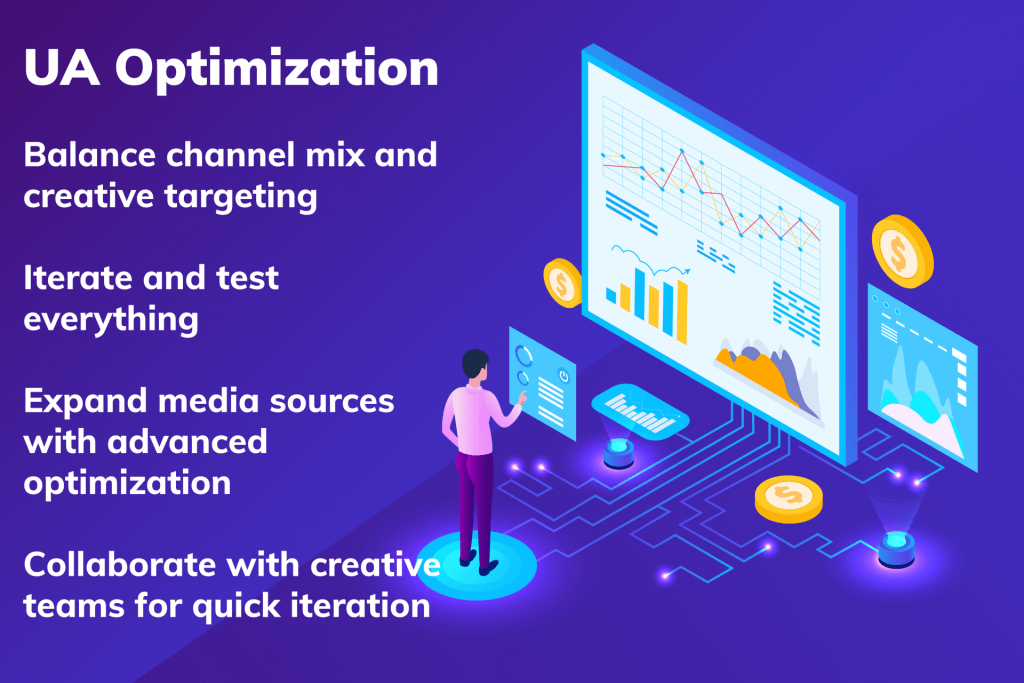
Balancing channel mix, creative targeting, and buying targets
Your optimization strategy is built on three pillars: channel mix, creative targeting, and buying targets. The challenge lies in finding the right balance between these elements to hit your buying targets while maintaining profitability. This involves pushing your creatives through selected ad channels – ensuring they resonate with your target audience and drive cost-effective installs.
Testing and Iteration: The key to success
Testing user reactions and refining ad campaigns is crucial to achieving maximum ROAS. While the initial focus of ad campaigns is often on media sources that are commonly used by competitors – such as Facebook, Google, and SDK networks like Unity or AppLovin – it’s important to continuously test different media sources, pausing those that underperform and reallocating the budget to more successful channels. This iterative approach ensures that the campaign remains agile and responsive to changing market conditions.
Expanding media sources and advanced optimization
As your game matures and the team gains a clearer understanding of key performance indicators (KPIs) and the payback window, it becomes possible to experiment with more niche media sources. These might include incentivized shopping platforms or demand-side platforms (DSPs), which offer advanced targeting and optimization capabilities. Introducing advanced campaign optimization techniques, such as value optimization, can further enhance performance by focusing on maximizing the lifetime value of acquired users.
Collaboration and creative iteration
Throughout the optimization process, close collaboration with the creative team is vital. As the campaign scales, the need for fresh, engaging creatives grows. Regularly updating and testing new creatives helps maintain campaign effectiveness and ensures that the ads continue to capture the attention of potential players. By keeping the creative strategy aligned with overall campaign goals, the team can drive sustained growth and achieve long-term success.
Key takeaways
User acquisition (UA) is crucial for successful game marketing, focusing on attracting and retaining players who drive long-term growth. It’s not just about acquiring a large user base but about engaging high-quality players who contribute to sustained revenue. A well-structured UA funnel guides players from awareness to active engagement, while continuous optimization ensures each stage is efficient and profitable.
Strategic channel selection, from social platforms to rewarded video networks to demand-side platforms (DSPs), combined with iterative creative testing, helps create compelling campaigns that attract and retain users. Collaboration with creative teams is vital to keep content fresh and engaging. Tools like Upptic for automation, MMPs for precise tracking, and data warehouses for deep analysis allow marketers to refine their strategies, maximizing ROI and ensuring game success in a competitive market.
Reach out to Upptic today to see how we can help you with your user acquisition!
Further reading
To learn more about game marketing and user acquisition, check out the following articles!

